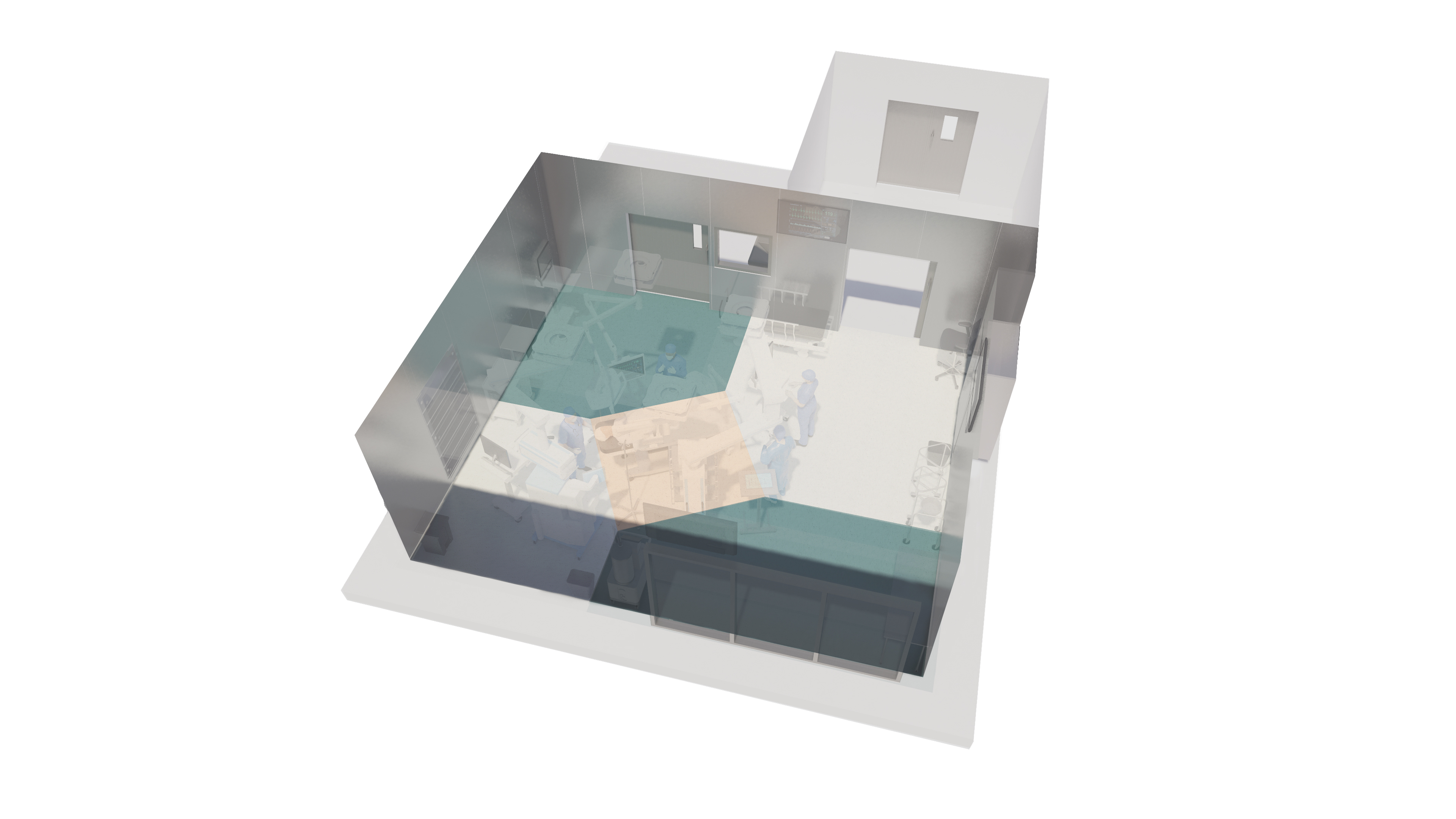TYPE OF STRATEGIES
To view citation, click on desired outcomes below.
Slip-resistant flooring supports reduced potential for hazards such as slips, trips, and falls by eliminating surface irregularities.
DESIRED OUTCOMES/CITATIONS
Peer-reviewed (empirical study)
Bell et al., 2008
Bell, J. L., Collins, J. W., Wolf, L., Grönqvist, R., Chiou, S., Chang, W. R., ... & Evanoff, B. (2008). Evaluation of a comprehensive slip, trip and fall prevention programme for hospital employees. Ergonomics, 51(12), 1906-1925.
Peer-reviewed (best practice, design guidelines, or literature review report)
Gupta et al, 2015
Gupta, C., Vanathi, M., & Tandon, R. (2015). Current concepts in operative room sterilisation. The Official Scientific Journal of Delhi Ophthalmological Society, 25(3), 190-194.
Peer-reviewed (best practice, design guidelines, or literature review report)
Brogmus et al., 2007
Brogmus, G., Leone, W., Butler, L., & Hernandez, E. (2007). Best practices in OR suite layout and equipment choices to reduce slips, trips, and falls. AORN journal, 86(3), 384-398.
TYPE OF STRATEGY
Built EnvironmentModular wall systems support the ability to minimize downtime and service disruptions during maintenance, repairs and renovation.
DESIRED OUTCOMES/CITATIONS
Best Practice report (non peer-reviewed)
Joseph & Allison, 2018
Joseph, A. & Allison, D. (2018). Designing A Safer OR. Healthcare Design Magazine. Available at https://www.healthcaredesignmagazine.com/trends/research-theory/designing-a-safer-or/
Best Practice report (non peer-reviewed)
Lee, 2015
Lee, K. (2015). Designing The OR Of The Future. Healthcare Design Magazine. Available at https://www.healthcaredesignmagazine.com/trends/construction-engineering/designing-or-future/?hilite=%27designing%27%2C%27Future%27
TYPE OF STRATEGY
Built EnvironmentSkirting with surfaces that retain disinfectant longer maximize the effect of cleaning products and support effective sanitization practices.
DESIRED OUTCOMES/CITATIONS
Peer-reviewed (empirical study)
Frabetti et al., 2009
Frabetti, A., Vandini, A., Balboni, P., Triolo, F., & Mazzacane, S. (2009). Experimental evaluation of the efficacy of sanitation procedures in operating rooms. American Journal of infection control, 37(8), 658-664.
TYPE OF STRATEGY
Task Built EnvironmentMinimizing fixed horizontal surfaces that are hard to reach supports effective sanitization practices by reducing the amount of surfaces that can potentially collect contaminating agents.
DESIRED OUTCOMES/CITATIONS
Peer-reviewed (empirical study)
Frabetti et al., 2009
Frabetti, A., Vandini, A., Balboni, P., Triolo, F., & Mazzacane, S. (2009). Experimental evaluation of the efficacy of sanitation procedures in operating rooms. American Journal of infection control, 37(8), 658-664.
Best Practice report (non peer-reviewed)
Joseph & Allison, 2018
Joseph, A. & Allison, D. (2018). Designing A Safer OR. Healthcare Design Magazine. Available at https://www.healthcaredesignmagazine.com/trends/research-theory/designing-a-safer-or/
Flooring that does not require waxing to maintain its functional integrity supports effective cleaning and sanitization practices.
DESIRED OUTCOMES/CITATIONS
Peer-reviewed (empirical study)
Frabetti et al., 2009
Frabetti, A., Vandini, A., Balboni, P., Triolo, F., & Mazzacane, S. (2009). Experimental evaluation of the efficacy of sanitation procedures in operating rooms. American Journal of infection control, 37(8), 658-664.
TYPE OF STRATEGY
Task Built EnvironmentConsidering flooring that supports staff ergonomic needs such as underfoot comfort, while at the same time evaluating alignments and tradeoffs with other criteria (e.g., equipment movement and cleaning), facilitates postural stability, balance, and underfoot comfort, as well as ease of movement of wheeled equipment and furniture.
DESIRED OUTCOMES/CITATIONS
Peer-reviewed (best practice, design guidelines, or literature review report)
FGI Guidelines, Hospitals, 2018
Facility Guidelines Institute. (2018). 2018 FGI Guidelines for Design and Construction of Hospitals. Washington, D.C.: Facility Guidelines Institute.
TYPE OF STRATEGY
People Task Built EnvironmentFlush flooring transitions at entry and exit points of the OR support the potential for reducing hazards related to slips, trips, and falls.
DESIRED OUTCOMES/CITATIONS
Peer-reviewed (best practice, design guidelines, or literature review report)
FGI Guidelines, Hospitals, 2018
Facility Guidelines Institute. (2018). 2018 FGI Guidelines for Design and Construction of Hospitals. Washington, D.C.: Facility Guidelines Institute.
Peer-reviewed (empirical study)
Bell et al., 2008
Bell, J. L., Collins, J. W., Wolf, L., Grönqvist, R., Chiou, S., Chang, W. R., ... & Evanoff, B. (2008). Evaluation of a comprehensive slip, trip and fall prevention programme for hospital employees. Ergonomics, 51(12), 1906-1925.
TYPE OF STRATEGY
Built EnvironmentEasily cleanable interior surface materials applied to floors, walls, and furnishings with surfaces support effective sanitization practices.
DESIRED OUTCOMES/CITATIONS
Peer-reviewed (empirical study)
Frabetti et al., 2009
Frabetti, A., Vandini, A., Balboni, P., Triolo, F., & Mazzacane, S. (2009). Experimental evaluation of the efficacy of sanitation procedures in operating rooms. American Journal of infection control, 37(8), 658-664.
Best Practice report (non peer-reviewed)
Joseph & Allison, 2018
Joseph, A. & Allison, D. (2018). Designing A Safer OR. Healthcare Design Magazine. Available at https://www.healthcaredesignmagazine.com/trends/research-theory/designing-a-safer-or/
Peer-reviewed (best practice, design guidelines, or literature review report)
FGI Guidelines, Hospitals, 2018
Facility Guidelines Institute. (2018). 2018 FGI Guidelines for Design and Construction of Hospitals. Washington, D.C.: Facility Guidelines Institute.
TYPE OF STRATEGY
Task Built EnvironmentFlush interior flooring, wall, and ceiling surfaces with minimal joints, crevices and articulations support effective sanitization practices.
DESIRED OUTCOMES/CITATIONS
Peer-reviewed (best practice, design guidelines, or literature review report)
Gupta et al, 2015
Gupta, C., Vanathi, M., & Tandon, R. (2015). Current concepts in operative room sterilisation. The Official Scientific Journal of Delhi Ophthalmological Society, 25(3), 190-194.
Peer-reviewed (empirical study)
Joseph et al., 2018
Joseph, A., Bayramzadeh, S., Zamani, Z., & Rostenberg, B. (2018). Safety, Performance, and Satisfaction Outcomes in the Operating Room: A Literature Review. HERD: Health Environments Research & Design Journal, 11(2), 137-150.
Peer-reviewed (empirical study)
Leest et al., 2012
Leest, L. V., Kawczynski, R., Lipp, F. E., & Barrientos, R. (2012). Identifying potential areas of infectivity on high-touch locations in the OR. AORN journal, 96(5), 507-512.
Best Practice report (non peer-reviewed)
Joseph & Allison, 2018
Joseph, A. & Allison, D. (2018). Designing A Safer OR. Healthcare Design Magazine. Available at https://www.healthcaredesignmagazine.com/trends/research-theory/designing-a-safer-or/
Best Practice report (non peer-reviewed)
Joseph & Allison, 2018
Joseph, A. & Allison, D. (2018). Designing A Safer OR. Healthcare Design Magazine. Available at https://www.healthcaredesignmagazine.com/trends/research-theory/designing-a-safer-or/
Best Practice report (non peer-reviewed)
Joseph & Allison, 2018
Joseph, A. & Allison, D. (2018). Designing A Safer OR. Healthcare Design Magazine. Available at https://www.healthcaredesignmagazine.com/trends/research-theory/designing-a-safer-or/
TYPE OF STRATEGY
Task Built Environment



